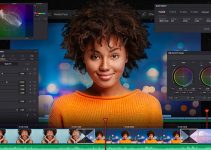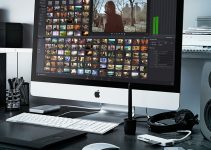Having a compact, portable video editing system can make a world of difference in the lives of a growing number of professional editors, who up until very recently were relegated to dark rooms like trolls, to breathe the stale edit suite air, and toil over projects in isolation amid the deafening buzzing of processors and hard drives.
Now laptops have the connectivity, speed, and capacity to handle full projects without additional peripherals, freeing the pasty editor from their sheltered servitude and shining a ray of hope into their otherwise secluded lives. But does the 2020 13″ MacBook Pro have the muscle it takes to drive this editing revolution, or will it be cut down by its (slightly) older brother, the 2019 16″ MacBook Pro?
Max Yuryev put the 13″ MBP and the 16″ MBP through a series of real-world tests to see how they hold up against each other.
The 16″ MacBook Pro was the first laptop that I would consider a useable editing machine for a professional post production environment. It can be configured with enough processing power, ram, and internal storage to edit entire projects completely on its own without any additional drives or eGPUs attached.
There is a massive difference in the size of the 13″ MBP and the 16″ MBP. The 13″ is much more compact with some very similar specs, which is why so many people are interested to know if it is useable as their editing machine.
2020 13″ MacBook Pro Specs In This Test
- 2.0GHz quad-core 10th-generation Intel Core i5 processor
- Turbo Boost up to 3.8GHz
- Intel Iris Plus Graphics
- 16GB 3733MHz LPDDR4X memory
- 512GB SSD storage
- 13-inch Retina display with True Tone
- Magic Keyboard
- Touch Bar and Touch ID
- Four Thunderbolt 3 ports
- Price $1,799.00
2019 16″ MacBook Pro Specs In This Test
- 2.6GHz 6-core 9th-generation Intel Core i7 processor
- Turbo Boost up to 4.5GHz
- AMD Radeon Pro 5300M with 4GB of GDDR6 memory
- 16GB 2666MHz DDR4 memory
- 512GB SSD storage
- 16-inch Retina display with True Tone
- Touch Bar and Touch ID
- Four Thunderbolt 3 ports
- Price $2,399.00
TEST NO. 1 – Footage Stabilization
Stabilizing footage in post is something video editors have to do everyday, and it requires a lot of processing power. For this test, Max timed the 13″ and the 16″ using the same 20 second clip in Final Cut Pro, DaVinci Resolve, and Adobe Premiere Pro.
As you can see, the 16″ MBP is nearly 3x faster at stabilizing the 20 second clip in every application except Premiere Pro – which is unbelievably slow at stabilizing footage compared to the other programs. The 16″ was able to stabilize the entire clip in 9 seconds in FCPx, and 21 seconds in Resolve, whereas the 13″ took 20 seconds in FCPx, and 64 seconds in Resolve.
With only a $600 difference in price there is a serious disparity in the performance of these 2 machines. A lot of that has to do with the 16″ MBP’s AMD graphics card compared to the Intel Iris Plus Graphics card that is integrated into the motherboard of the 13″ MBP.
The AMD graphics card on the 16″ is doing a lot of the processing in FCPx and Resolve, and I am assuming the warp stabilizer in Premiere is CPU based only.
TEST No. 2 – 5 Minute Project
Working in a 5 minute 4k Project on both the 13 and 16 MBPs, Max’s test show that the 13″ MBP starts to lag with just 2 LUTs placed on it in FCPx. The 16″ MBP is operating without any issues with a number of LUTs placed on it in FCPx, Resolve, and Premiere. The 13″ MBP in Premiere suffers lagging right off the bat with playback speeds of 15fps.
Exporting the same 5 minute project results in 3x faster speeds with the 16″ MBP – it really seems to be leaving the 13″ in the dust.
TEST NO. 3 – C200 Raw Footage
The Canon C200 offers fantastic image quality in RAW, but it’s well known that the compressed nature of this codec is rather intensive on any editing system. For whatever reason, FCPx seems to handle C200 RAW footage the best and in this test the 13″ MBP did reasonably well playing C200 footage without much lag. However, exporting the footage is a whole other story.
Exporting C200 RAW footage in FCPx with the 13″ MBP took 4x as long as it took the 16″ MBP.
TEST NO. 4 – Blackmagic Raw
According to the Blackmagic RAW Speed Testing app, the 13″ MBP should be able to handle BRAW with easy, but for whatever-reason, this tiny laptop can only manage to playback the footage at 3fps while the 16″ MBP had no issues playing the footage back at full speed.
Upon export, the same clip that took the 13″ over 60 minutes was processed by the 16″ MBP in about 4 minutes.
Conclusion
With only a $600 difference in price, it seems like the 16″ MBP is really worth the extra investment. All of the shortcomings of the 13″ MBP for video editing stem from it’s integrated graphics card. Unfortunately, there is no option to upgrade the 13″ MBP’s graphics card.
Being completely honest (and I realize I should have mentioned this upfront), I’m writing this on a 16″ MacBook Pro so I’m also a little biased. Regardless of that, I think these test results speak for themselves.
This doesn’t mean that the 13″ isn’t a useful editing system but splurging the additional $600 for the 16″ will save you an awful lot of time in post.
Personally, I recently upgraded to a 16″ MacBook Pro specifically for the graphics card, and the outstanding SSD capacity. The majority of the long form projects that I work on edit with proxy media that is up to 2-3TBs per episode. I was previously editing on a Mac Mini with an eGPU (AMD Radeon Pro WX 9100 Graphics Card), external drives, 2x 21:9 monitors, and a UPS (Uninterruptible Power Supply).
Shifting over to a 16″ MacBook Pro, I can take my work on the go when necessary with the 8TB internal drive and also plug into my eGPU via Thunderbolt 3 to have the desktop experience when needed. I had considered the 13″ MBP but didn’t find it to be powerful enough for my needs, and also the screen was just a little too small.
[source: Max Yuryev]
Order Links:
Apple 13.3″ MacBook Pro with Retina Display (B&H, Amazon)
Apple 16″ MacBook Pro (Late 2019, Space Gray) (B&H, Amazon)
Disclaimer: As an Amazon Associate partner and participant in B&H and Adorama Affiliate programmes, we earn a small comission from each purchase made through the affiliate links listed above at no additional cost to you.
Claim your copy of DAVINCI RESOLVE - SIMPLIFIED COURSE with 50% off! Get Instant Access!





